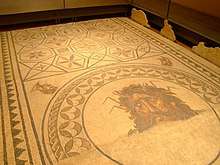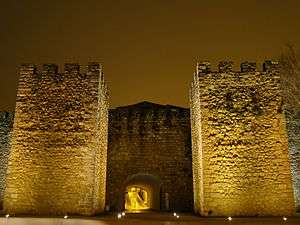Algarve
The Algarve (UK: /ælˈɡɑːrv, ˈælɡ-/, US: /ɑːlˈɡɑːrvə, ælˈ-/,[4][5][6][7][8][9] Portuguese: [alˈɡaɾvɨ] (![]()
Algarve Distrito de Faro | |
|---|---|
.jpg) Algarve's typical coast (Marinha Beach, near Lagoa) | |
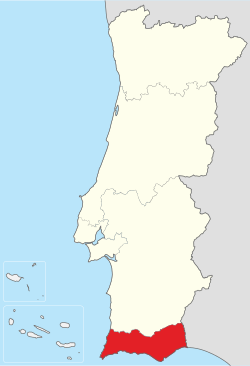 Location of the Algarve Region in relation to the national borders | |
| Country | Portugal |
| Region | Algarve |
| Area | |
| • Total | 4,996.80 km2 (1,929.28 sq mi) |
| Population (2011) | |
| • Total | 451,006 |
| • Density | 90/km2 (230/sq mi) |
| Time zone | UTC+0 (WET) |
| • Summer (DST) | UTC+1 (WEST) |
| HDI (2017) | 0.831[1] very high · 3rd |
| GDP (PPP) | 2019 estimate |
| – Total | €9,274 billion[2] |
| – Per capita | €24,900[3] |
| GDP (nominal) | 2019 estimate |
| Website | www |
| Statistics from INE (2005); geographic detail from Instituto Geográfico Português (2010) | |
The region has its administrative centre in the city of Faro, where both the region's international airport (IATA: FAO) and public university, the University of Algarve, are located. The region coincides with Faro District. Tourism and related activities are extensive and make up the bulk of the Algarve's summer economy. Production of food, which includes fish and other seafood, different types of fruit such as oranges, figs, plums, carob beans, and almonds, are also economically important in the region.
Although Lisbon surpasses the Algarve in terms of tourism revenue,[13] the Algarve is still, overall, considered to be the biggest and most important Portuguese tourist region, having received an estimated total of 7.1 million tourists in 2017.[14] Its population triples in the peak holiday season due to seasonal residents.[15] Due to the high standards of quality of life, mainly regarding safety and access to public health services, as well as due to cultural factors and considerably good weather conditions, the Algarve is becoming increasingly sought after, mostly by central and northern Europeans, as a permanent place to settle.[16] A 2016 American-based study concluded that the Algarve was the world's best place to retire.[17]
The Algarve is one of the most developed regions of Portugal and, with a GDP per capita at 83% of the European Union average, it has the second highest purchasing power in the country, standing only behind Lisbon.[3]
History
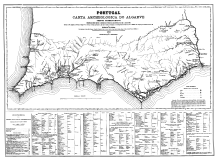
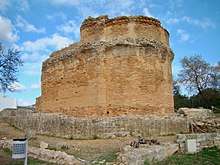
Pre-Historic times
Human presence in southern Portugal dates back to the Paleolithic and Neolithic periods. The presence of megalithic stones in the area of Vila do Bispo, Lagos, Alcoutim and elsewhere in the region attests to this presence.[18]
The Cynetes were established by the sixth century BC in the region of the Algarve (called Cyneticum). They were strongly influenced by the Celtici. Those Indo-European tribes, Celtic or pre-Celtic, founded the city of Lagos (then called Lacóbriga). The Cynetes, also known as Conii were further influenced by the neighbouring Tartessos. Phoenicians had established semi-permanent trading posts along the coast c. 1000 BC. Some sources claim that the Carthaginians founded Portus Hanibalis – known today as Portimão – c. 550 BC.
Roman period
The Algarve region came under Roman control after Fabius Maximus Servilianus defeated the Lusitanians and the Turduli in the context of the Lusitanian War, as was the case of much of the Iberian Peninsula, which was absorbed into the Roman Republic in the second century BC. Cyneticum (in reference to the Cynetes who inhabited the region), as it was then called, became integrated into Hispania Ulterior and into Lusitania afterwards, being under Roman influence for around 600 years (from 200 BC till 410 AD), having thus adopted Latin as the official language, as well as Roman cultural, political, architectonic, religious and economic tenets.
Seeing that during this time traveling through the land was dangerous, its geography meant that Cyneticum was of crucial importance as a passageway between the Mediterranean and the Atlantic Ocean, connecting countless Roman ports to several provinces, mainly in other parts of Hispania, Gaul and Britannia. This meant that the region experienced a great level of prosperity accrued through an expansion of its trading and commercial capabilities, mainly from the production and commercialization of olive oil and garum, products very much sought after throughout the Roman Empire.[19] As Christianity rose in popularity, becoming the official religion of the Roman Empire under Constantine the Great, Cyneticum, following the same tendency of the rest of the Roman provinces, made the transition from a polytheistic society into a monotheistic one. The region made a gradual changeover into Christianity, as Pagan and Animistic religions became obsolete under this new cultural influence. Roman Emperor Theodosius I, himself a native of the Iberian Peninsula, would come to prohibit Paganism in 381. The Roman Temple of Milreu, originally dedicated to Venus, transformed later on into a Paleochristian temple, is an example of the religious changes that took place in this period.[20]
Many Roman ruins, both in the form of temples, countryside villas (of which more than 30 were found in the Algarve), public baths, bridges, salting and fish-processing facilities and mosaics are widespread all over the region, notably in Vila do Bispo, Lagos, Portimão, Quarteira, Faro, Olhão, Tavira and in other areas, illustrating the strong contributions that Roman culture as a whole made to the Algarve.[21][22][23]
Visigothic Kingdom and Moorish Occupation

After the fall of the Western Roman Empire, the Visigoths, a Germanic tribe originally from Scandinavia but who had spread into Eastern Europe, occupied the Iberian Peninsula around the year 500. With the death of Amalaric in 531, the original dynastic shape of the Visigoths came to an end, and out of the fusion of the Roman and Germanic components a new Iberian identity came into being. The Visigothic Kingdom was thus founded in 542, with Toledo as its capital. Practicing Arianism at first, a big portion of the Visigoths eventually adopted Catholicism to secure their position in the region.[24] In 552, the Algarve was conquered by the Byzantine Empire and, in 571, Liuvigild managed to secure the region for the Visigothic Kingdom once again, which lasted until the year 711, and comprised most of the Iberian Peninsula and parts of modern France. Although already Christian as a whole, some of these Germanic peoples were still Pagan and thus brought Paganism back to the Iberian Peninsula, where it marginally co-existed with Christianity. Visigothic influence was such that many authors characterized it has having been a reconstituent force in the Iberian Peninsula. According to Ramón Menéndez Pidal, "the blonde aristocrats of the Kingdom of Toledo are at the root of national literature.".[24]
The Visigoths reigned until the beginning of the Umayyad conquest of Hispania and, although not nearly as influential as the Romans, left some influence in the Algarve, both in words that were, after the Moorish Occupation, added to the lexicon, which are still present in modern-day Portuguese, as well as in local architecture. Several Visigothic Necropolis were found in the Algarve, suggesting that the presence was likely more significant than once believed.[25]
When the Moors conquered Lagos in 716, it was renamed Zawaia. Faro, which the Christian residents had called Santa Maria, was renamed Faraon, which means "settlement of the knights". Due to the conquest of the Iberian Peninsula, the region was called Gharb Al-Andalus: Gharb means "the west", while al-Andalus is the Arabic name for the Iberian Peninsula. For several years, the town of Silves was the capital of the region. In the mid-13th century, during the Reconquista, the Kingdom of Portugal took over the region in a series of successful military campaigns against the Moors. Al-Gharb became the Kingdom of the Algarve, and the Moors were expelled in 1294. There were subsequent Moorish attempts to recapture the region, without success. King Afonso III of Portugal started calling himself King of Portugal and the Algarve. After 1471, with the conquest of several territories in the Maghreb – the area considered an extension of the Algarve – Afonso V of Portugal began fashioning himself "King of Portugal and the Algarves", referring to the European and African possessions. The over five centuries-long Moorish rule over the Algarve (and Alentejo), left their mark and added to a unique blend of architectonic,[26][27][28] gastronomical[29]and artistic features[30] like the traditional Algarve corridinho,[31] a folk dance found in this southernmost region of Portugal.
Modern times
Prior to the independence of Brazil, "United Kingdom of Portugal, Brazil, and the Algarves" (1815–1822) was an official designation for Portugal which also alluded to the Algarve. Portuguese monarchs continued to use this title until the proclamation of the First Portuguese Republic in 1910. Between 1595 and 1808, the Algarve was a semiautonomous area of Portugal with its own governor, as well as a separate taxation system.
In the 15th century, Prince Henry the Navigator based himself near Lagos and conducted various maritime expeditions which established the colonies that comprised the Portuguese Empire. Also from Lagos, Gil Eanes set sail in 1434 to become the first seafarer to round Cape Bojador in West Africa. The voyages of discovery brought Lagos fame and fortune. Trade flourished and Lagos became the capital of the historical province of Algarve in 1577 and remained so until the fabled 1755 Lisbon earthquake. The earthquake damaged many areas in the Algarve and an accompanying tsunami destroyed or damaged coastal fortresses, while coastal towns and villages were heavily damaged except Faro, which was protected by the sandy banks of Ria Formosa lagoon. In Lagos, the waves reached the top of the city walls. For many Portuguese coastal regions, including the Algarve, the destructive effects of the tsunami were more disastrous than those of the earthquake itself.
In 1807, while Jean-Andoche Junot led the first Napoleonic invasion in the north of Portugal, the Algarve was occupied by Spanish troops under Manuel Godoy. Beginning in 1808, and after subsequent battles in various towns and villages, the region was the first to drive out the Spanish occupiers. During the Portuguese Civil War, several battles took place in the region, especially the battle of Cape St. Vicente and the battle of Sant’Ana, between liberals and Miguelites. Remexido was the guerrilla Algarvian leader who stood with the Miguelite absolutists for years, until he was executed in Faro in 1838.[32]
The establishment of the First Portuguese Republic in 1910 marked the end of the Kingdom of Portugal and the Algarve. The Algarve is a somewhat exotic region for the Portuguese, due to the Mediterranean climate, unique foods, architecture, and geographical location- many Portuguese traditionally spend their Summer break or own a holiday home in the Algarve.
Geography
The Algarve covers 4997 km2,[10] extending just south of the Tagus valley to the southern coast of the Iberian Peninsula, joining Spain. Its highest point is Fóia, 902 m (2,959 ft), in the mountain range of Monchique. It also includes some islands and islets. The region is also the home of the Ria Formosa Lagoon, a nature reserve of over 170 km2 and a stopping place for hundreds of different species of birds. The length of the south-facing coastline is roughly 155 km. Beyond the westernmost point of Cape St. Vincent it stretches a further 50 km to the north. The coastline is notable for picturesque limestone caves and grottoes, particularly around Lagos, which are accessible by powerboat.
Climate
The maximum recorded temperatures in the Algarve fluctuate between 25 °C (77 °F) in winter and over 40 C in summer, with the temperature rarely falling below freezing in the winter. The winter of 2008–09 was exceptionally cold and wet, with below-freezing temperatures (sub-0 °C (32 °F)) recorded in coastal areas for the first time in many years.
Generally, winter sees only subtle differences in daily maxima along the coastal Algarve, Tavira in the Eastern Algarve may see 16–17 °C (61–63 °F), Faro and Quarteira in the central Algarve broadly similar values, whist Sagres and the peninsula in the extreme west experiences more frontal activity off storms in the Atlantic and generally 15 °C (59 °F) is the maximum daytime temperature. Conversely, overnight lows are higher in Sagres, at 9 °C (48 °F), whilst to the East 7–8 °C (45–46 °F) is more common.
Summer sees the highest average coastal temperatures in Faro and most points east, maxima around 29–30 °C (84–86 °F), whilst points west of Faro to about Lagos are in the range 27–29 °C (81–84 °F). The peninsula and Sagres see the coolest of the summer temperatures, being prone to the cooler North Westerly winds that topple round the Azores high so here we see 24–26 °C (75–79 °F) more typically. Overnight lows are in the region of 17–19 °C (63–66 °F) the higher values in Faro and to the east.
Year to year, there can be considerable differences in the sea surface temperatures off the Algarve during the summer/early Autumn. In recent years, the sea temperatures have struggled to exceed 18–19 °C (64–66 °F) till later in August, then weather conditions have encouraged a warm outflow from the Mediterranean, temporarily bathing the Algarve in warm surface water and sea temperatures can rise, very rapidly over a week or so, to 25 °C (77 °F) and only slowly drop away during October. This warm plume of water can add some noticeable humidity to an otherwise very comfortable summer feel, temperature-wise.
Inland Algarve sees higher daytime temperatures than the coast, typically 31–33 °C (88–91 °F) whilst overnight temperatures drop away to 16–18 °C (61–64 °F). Heatwaves can occasionally push the mercury to 45 °C (113 °F) and at this intensity, overnight lows can remain uncomfortably high at over 25 °C (77 °F).
| Climate data for Faro | |||||||||||||
|---|---|---|---|---|---|---|---|---|---|---|---|---|---|
| Month | Jan | Feb | Mar | Apr | May | Jun | Jul | Aug | Sep | Oct | Nov | Dec | Year |
| Record high °C (°F) | 21.9 (71.4) |
24.7 (76.5) |
28.9 (84.0) |
30.1 (86.2) |
33.6 (92.5) |
37.1 (98.8) |
44.3 (111.7) |
39.6 (103.3) |
37.4 (99.3) |
33.3 (91.9) |
28.6 (83.5) |
24.0 (75.2) |
44.3 (111.7) |
| Average high °C (°F) | 16.1 (61.0) |
16.9 (62.4) |
19.1 (66.4) |
20.4 (68.7) |
22.8 (73.0) |
26.4 (79.5) |
29.2 (84.6) |
28.8 (83.8) |
26.6 (79.9) |
23.2 (73.8) |
19.6 (67.3) |
17.0 (62.6) |
22.2 (72.0) |
| Daily mean °C (°F) | 12.0 (53.6) |
12.8 (55.0) |
14.8 (58.6) |
16.1 (61.0) |
18.4 (65.1) |
21.9 (71.4) |
24.2 (75.6) |
24.1 (75.4) |
22.3 (72.1) |
19.3 (66.7) |
15.7 (60.3) |
13.3 (55.9) |
17.9 (64.2) |
| Average low °C (°F) | 7.9 (46.2) |
8.7 (47.7) |
10.5 (50.9) |
11.8 (53.2) |
14.0 (57.2) |
17.3 (63.1) |
19.1 (66.4) |
19.4 (66.9) |
18.0 (64.4) |
15.3 (59.5) |
11.7 (53.1) |
9.6 (49.3) |
13.6 (56.5) |
| Record low °C (°F) | −1.2 (29.8) |
−1.2 (29.8) |
2.3 (36.1) |
3.6 (38.5) |
6.7 (44.1) |
8.0 (46.4) |
11.9 (53.4) |
13.1 (55.6) |
9.9 (49.8) |
7.8 (46.0) |
2.7 (36.9) |
1.2 (34.2) |
−1.2 (29.8) |
| Average precipitation mm (inches) | 59.3 (2.33) |
52.0 (2.05) |
39.4 (1.55) |
38.6 (1.52) |
21.7 (0.85) |
4.3 (0.17) |
1.8 (0.07) |
3.9 (0.15) |
23.2 (0.91) |
60.1 (2.37) |
90.4 (3.56) |
114.1 (4.49) |
508.8 (20.03) |
| Average precipitation days (≥ 0.1 mm) | 12 | 13 | 9 | 10 | 7 | 4 | 1 | 1 | 3 | 9 | 10 | 11 | 90 |
| Mean monthly sunshine hours | 170.5 | 165.2 | 232.5 | 252.0 | 313.1 | 333.0 | 368.9 | 353.4 | 273.0 | 226.3 | 183.0 | 167.4 | 3,038.3 |
| Source: Instituto de Meteorologia,[33] World Meteorological Organization[34] (precipitation days), Hong Kong Observatory[35](sunshine hours) | |||||||||||||
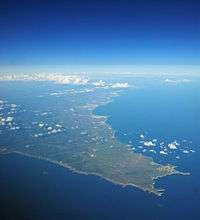
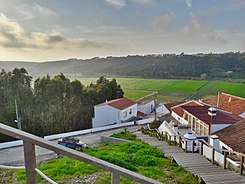

Human geography
About 450,000 permanent inhabitants (90 residents per km2) live in the area, although this figure increases to over a million people at the height of summer, due to an influx of tourists. The Algarve has several cities, towns, and villages; the region's capital is the city of Faro, while other cities include Albufeira, Lagoa, Lagos, Loulé, Olhão, Portimão, Quarteira, Silves, Tavira, and Vila Real de Santo António, in addition to various summer retreats such as Vilamoura, Praia da Rocha, Armação de Pêra, Alvor, Monte Gordo, Tavira, and Sagres.
Before 2004, the Faro District was the administrative unit governing the Algarve. In 2004, the Greater Metropolitan Area of the Algarve was formed, which was converted into an intermunicipal community in 2008.[36] Algarve is also a NUTS II and NUTS III statistical region.[37] The intermunicipal community of Algarve is subdivided into 16 municipalities:[12]
| Municipality | Population (2011)[11] | Area (km²)[10] |
|---|---|---|
| Albufeira | 40,828 | 140.66 |
| Alcoutim | 2,917 | 575.36 |
| Aljezur | 5,884 | 323.50 |
| Castro Marim | 6,747 | 300.84 |
| Faro | 64,560 | 202.57 |
| Lagoa | 22,975 | 88.25 |
| Lagos | 31,049 | 212.99 |
| Loulé | 70,622 | 763.67 |
| Monchique | 6,045 | 395.30 |
| Olhão | 45,396 | 130.86 |
| Portimão | 55,614 | 182.06 |
| São Brás de Alportel | 10,662 | 153.37 |
| Silves | 37,126 | 680.06 |
| Tavira | 26,167 | 606.97 |
| Vila do Bispo | 5,258 | 179.06 |
| Vila Real de Santo António | 19,156 | 61.25 |
| Total | 451,006 | 4996.80 |
Economy

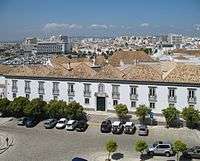
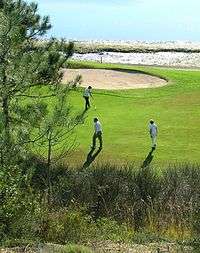
Agricultural products of the region include fig, almond, orange, carob bean, strawberry tree, and cork oak. Horticulture is important and the region's landscape is known for the large areas of land covered with plastic greenhouses which are used to that end. Fishing and aquaculture are important activities in the coastal area of the Algarve, with sardines, soles, cyprinids, gilt-head bream, and various seafood, including the grooved carpet shell, being the major products. The Algarve's wines are also renowned. Four wines in the region have Protected Designation of Origin (Denominação de Origem Controlada – DOC): Lagoa DOC, Lagos DOC, Portimão DOC, and Tavira DOC. Food processing, cement and construction are the main industries. Tourism-related activities are extensive and make up the bulk of the Algarve's economy during summer. The Algarve's economy has always been closely linked to the sea, and fishing has been an important activity since ancient times. Only since the 1960s has the region embraced tourism, which has become its most important economic activity. With the increase in life quality and purchasing power, many shopping malls have been constructed, mostly in the past 15–20 years. Recently, an Ikea opened in Loulé, one of five in Portugal.
In 2017, the Algarve was the Portuguese region that experienced the biggest economic growth, an increase of 4.6% of its GDP.[38]
Development
The Algarve has been experiencing a strong development since the beginning of the 1960s, initially due to the need to accommodate its foreign visitors. The region started the construction of better infrastructure, mainly roads, sanitation, power grids, telecommunications, hospitals, and housing. Due to the austerity measures introduced in 2011, tolls were placed on the main motorway that crosses the region to offset the expense of its maintenance. Private investors, with the support of municipalities, also began the construction of a variety of hotels, resorts, golf courses (which are considered to be some of the best in Europe), and villas. All this led to a large development in the region, especially for the locals, who had previously lived in harsher circumstances. Today, the Algarve is amongst the regions in Portugal with the best quality of life.[39]
Tourism
In the 1960s, the Algarve became a popular destination for tourists, mainly from the United Kingdom. It has since become a common destination for people from Germany, The Netherlands and Ireland. Many of these tourists own their a property in the region. Algarve-based publications and newspapers are written in English specifically for this community. In recent years, the Algarve has seen a high increase in tourists from France, Spain and Italy, followed by Canadians, Americans, and Australians. Portuguese people from other parts of the country also visit the region in large numbers, especially in the peak of the summer (July and August).
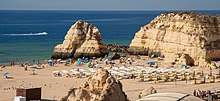
Tourist attractions in the region include its beaches, Mediterranean climate, safety, cuisine, and relatively low prices. Well-known beaches in the Algarve include Marinha Beach, Praia da Rocha and Armação de Pêra. A well-known spa town is Caldas de Monchique. In addition to its natural features and beaches, the Algarve has invested in the creation of a network of golf courses.
The Algarve is also popular for religious tourism, notably pilgrimages to the Sanctuary of Our Lady of Piety (best known as the Sovereign Mother), a Marian shrine dedicated to the patron saint of Loulé, that attract thousands of pilgrims of the Catholic faith to the city, or with the international pilgrimages to the site of the apparitions of Our Lady Mother of Goodness occurred near São Marcos da Serra.
The Algarve's mild climate attracts interest from Portuguese and Northern European people wishing to have a holiday home or residence in the region. Being a region of Portugal, and therefore in the European Union, any EU citizen has the right to freely buy property and reside with little formality in the Algarve.[40] British expatriates, followed by Germans, Dutch, and Irish, are among the largest groups wishing to own a home in this sunny region of Portugal.
Tourism plays an important role in the economy of the Algarve. A large number of seasonal job opportunities are tourism-related and are fulfilled by thousands of locals and immigrants. Due to its seasonal nature, most of the economy relies on the good weather available mostly for only about 5–6 months (characterised by a prolonged lack of rain and temperatures above 30 °C throughout the day), meaning that many Algarvians go unemployed during the low season. Nonetheless, due to the very high monetary income that the high season brings, most people in the Algarve are still able to have comfortable lives even while unemployed. In March 2007, the Portuguese economic minister, Manuel Pinho, announced the creation of the "Allgarve" brand, as a part of a strategic promotion of the Algarve as a tourism destination for foreign citizens.[41] According to World Travel Awards, the Algarve was Europe's leading golf destination in 2013 and 2014.[42][43] Over 25 top-class courses are located in the Algarve, most of which were designed by legendary names such as Nick Faldo, Seve Ballesteros, Jack Nicklaus, and Christy O'Connor, Jr.
In 2018, the region's income from tourism was over a billion euros; the number of visitors totaled 4.2 million. Tourism contributed €1.08 billion to the economy in that year.[44]
Although tourism and a generally high receptivity to globalism and external investment have brought a relatively high level of prosperity and development to the region, many personalities criticize the environmental impacts,[45] the high cost of living and the eradication of Algarve's cultural and traditional characteristics that such outside influence has brought.[46][47] Algarve native Fernando Silva Grade, a nationally renowned biologist, architect and activist, in his book O Algarve como o destruímos, vehemently opposed the proliferation of the mass tourism and construction sectors, which, in his opinion, eroded large portions of a world unique coastline, degraded and destroyed Algarve's traditional architecture, along with the peaceful and slow-paced way of life that were once ubiquitous throughout the region. He further went on to criticize the inapt attitudes of politicians and city halls which continuously fail to preserve this legacy.[48]
Other critics underline the over-dependency on the "sun and beach" modality of tourism, the one mostly advertised by local and national authorities and, thus, most widespread. They accentuate the saturation of beach-side resorts that leave other types of tourist establishments, such as the ones dedicated to nature and health, with little occupancy. These critics also stress that overcrowdedness, filthiness and pollution are the consequences of this lack of diversity in the Algarve's tourism industry.[49]
Accommodation
Accommodation in the Algarve ranges from high-rise resorts in places such as Albufeira, Vilamoura, Praia da Rocha and Armação de Pêra to apartment rental, bed and breakfast, hostels and traditional guesthouses located in small towns and villages, both inland and alongside the Algarve coast. Over the past few years, tourists with less acquisitive power have started visiting the Algarve in large numbers and steering away from expensive resorts, opting instead for more affordable touristic establishments such as guesthouses and hostels. Besides affordability, a higher flexibility in rules and conditions, good overall location, as well as a greater hospitality and interaction with guests, are often cited as some of the appealing factors of these accommodations. Throughout the Algarve, local accommodation, as its colloquially known, employs over 20 thousand people in more than 32 thousand legal establishments and generates an estimated 980 million Euros yearly. The vast majority of tourists who seek this type of accommodation are British, Portuguese and French, but an exponential increase in tourists from Germany, Spain and Brazil has also been seen.[50]
Education
The University of Algarve, headquartered in Faro, with an extension in Portimão, is a public university which awards all academic degrees in fields ranging from marine biology to economics to environmental engineering. Also, students are served by several private higher-education institutions (Piaget – Silves and others), state-run and private secondary schools, including a number of international schools, and a wide network of kindergartens and primary schools.
Sports
The Algarve has many sports clubs, including football teams (S.C. Olhanense, Portimonense S.C.) which play in the first, second, and third lay tiers of professional football. S.C. Farense is the most successful football club in the Algarve and play in the Campeonato de Portugal. There are numerous open-water swimming events throughout the year[51] as well as tennis. The Algarve is also home to some of the world’s most renowned golf-courses.[52]
Due to the strong Nortada winds blowing through the South coast of Portugal, Algarve is a popular summer holiday destination for the wind sports. Sailing, windsurfing and especially kitesurfing has a large and growing community. The nature of the Algarve coastline offers a mix of flat water lagoons such as those of the famous Ria Formosa Nature Park, or the waves of Sagres and the South-west coast.
There are many kitesurfing spots[53] dotted all along the Algarve coastline but the most popular are:
- Alvor lagoon (South, Lagos)
- Meia Praia (South, Lagos)
- Martinhal (South-west, Sagres)
- Tonel (South-west, Sagres)
- Praia Da Bordeira (South-west, Carrapateira)
- Amado (South-west, Carrapateira)
- Ilha de Culatra (South, Faro)
- Ilha da Barreta / Ilha Deserta (South, Faro)
- Barrinha (South, Faro)
- Praia de Faro (South, Faro)
- Praia Fuseta (South-east, Fuseta)
- Barril's Beach (South-east, Luz)
- Cabanas de Tavira (South-east, Tavira)
Culture



The Algarve is famous for its pottery and ceramics, particularly hand-painted pottery and azulejos, which are painted, tin-glazed ceramic tiles. Numerous ceramics and pottery outlets are open throughout the Algarve. For working potteries and ceramics workshops, the main (or best-known) pottery centers are located in the towns of Almancil, Porches, and Loulé, but many other potteries and workshops are in the Algarve region. Corridinho is the traditional dance of the Algarve.
Notable natives and inhabitants
- Aníbal Cavaco Silva (former Portuguese president and prime minister)
- Adelino da Palma Carlos (former Portuguese prime minister)
- António Calvário (singer)
- Bartolomeu Dias (navigator)
- Bonnie Tyler (singer)
- Cliff Richard (singer)
- Carlos Brito (politician and writer)
- Diogo Rodrigues (explorer of the Indian Ocean)
- Francisco Barreto (soldier and explorer; an officer in Morocco, viceroy of Portuguese India, he was tasked with an expedition to southeast Africa in search of legendary gold mines.)
- Gil Eannes (navigator)
- João de Deus (poet)
- João Moutinho (football player)
- João Vaz Corte-Real (claimed by some accounts to have been a pre-Columbian explorer of a land called New Land of the Codfish, possibly part of North America)
- José Mendes Cabeçadas (former Portuguese president and prime minister)
- Júlio Dantas (writer, doctor)
- Lídia Jorge (writer)
- Louis Van Gaal (former football player, Coach and Dutch National Team coach)
- Manuel Teixeira Gomes (former Portuguese president and writer)
- Maria Barroso (actress, wife of former Portuguese president and prime minister Mário Soares)
- Mário Centeno, (Portuguese Minister of Finance since 2015, president of the Eurogroup and Chairman of the Board of Governors of the European Stability Mechanism)
- Maria Margarida Pinto Ribeiro de Sousa Uva (wife of José Manuel Barroso, president of the European Commission and former prime minister of Portugal)
- Nuno Júdice (poet)
- Maria Keil (artist)
- Clive Dunn, British film and television actor (Dad's Army), from the 1980s until his death in 2012
- Patrick Swift (Artist, lived in Algarve from 1962 until his death in 1983, founded Porches Pottery/Olaria Algarve)
- Ronald Koeman (former football player, Coach and Dutch National Team coach)
- Katherine Swift (Artist and ceramicist. Worked at Porches Pottery and founded Estudio Destra in Silves.)
- Brites de Almeida (Aljubarrota battle events)
- Duarte Pacheco (engineer)
- Álvaro Esteves (15th century navigator)
Gallery
 The city of Tavira, capital of the Costa do Acantilado
The city of Tavira, capital of the Costa do Acantilado- The historic centre of Lagos
- Portimão at night
- A street in Silves
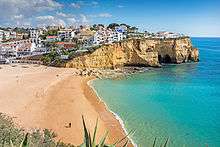 Partial view of Carvoeiro
Partial view of Carvoeiro- A beach in Albufeira
_(5469253558).jpg) The city of Vila Real de Santo António
The city of Vila Real de Santo António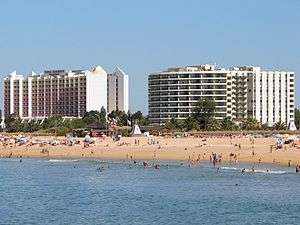 Marina beach in Vilamoura
Marina beach in Vilamoura Typical view of the Algarve coast
Typical view of the Algarve coast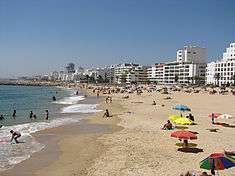 Beach in Quarteira
Beach in Quarteira Shepherd and sheep near Lagos
Shepherd and sheep near Lagos Desert island near Faro
Desert island near Faro Sagres Point, in the extreme of continental Portugal
Sagres Point, in the extreme of continental Portugal- Loulé's municipal market
- The bog fountain in Alte
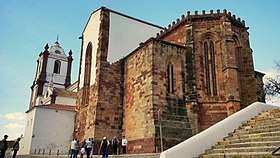
 The open fields of the Algarve in spring
The open fields of the Algarve in spring The spa resort town of Caldas de Monchique
The spa resort town of Caldas de Monchique
See also
References
- "Sub-national HDI - Area Database - Global Data Lab". hdi.globaldatalab.org. Retrieved 13 September 2018.
- "EU Regions". Eurostat.
- "Internal Market, Industry, Entrepreneurship and SMEs - Algarve Region of Portugal". European Commission. Retrieved 19 March 2020.
- Wells, John C. (2008). Longman Pronunciation Dictionary (3rd ed.). Longman. ISBN 978-1-4058-8118-0.
- Jones, Daniel (2011). Roach, Peter; Setter, Jane; Esling, John (eds.). Cambridge English Pronouncing Dictionary (18th ed.). Cambridge University Press. ISBN 978-0-521-15255-6.
- "Algarve". The American Heritage Dictionary of the English Language (5th ed.). Boston: Houghton Mifflin Harcourt. Retrieved 13 April 2019.
- "Algarve". Collins English Dictionary. HarperCollins. Retrieved 13 April 2019.
- "Algarve". Oxford Dictionaries UK Dictionary. Oxford University Press. Retrieved 13 April 2019.
- "Algarve". Merriam-Webster Dictionary. Retrieved 13 April 2019.
- "Áreas das freguesias, concelhos, distritos e país". Archived from the original on 5 November 2018. Retrieved 5 November 2018.
- "Statistics Portugal". ine.pt.
- "Law nr. 75/2013" (pdf). Diário da República (in Portuguese). Assembly of the Republic (Portugal). Retrieved 13 August 2014.
- "Lisboa ultrapassa pela primeira vez 1.000 milhões de euros em receitas de alojamento turístico" (Economy). O Jornal Económico. Archived from the original on 2 March 2018. Retrieved 26 February 2018.
- "Algarve com 4,2 milhões de turistas e 20 milhões de dormidas oficiais em 2017 - AHETA" (Economy). Diário de notícias. Retrieved 26 February 2018.
- "O "outro Algarve" é um paraíso". Sábado. Gonçalo Correia; Diogo Lopes. Retrieved 18 March 2020.
- "Algarve ganha 5.545 "novos cidadãos" num ano". Jornal do Algarve. Retrieved 18 March 2020.
- "Algarve once again elected best place in the world to retire". The Portugal News. 18 August 2016. Retrieved 22 November 2018.
- "Arqueologia no Algarve". E-cultura. Retrieved 18 March 2020.
- Viegas, Catarina (2011). A Ocupação Romana do Algarve (PDF). CENTRO DE ARQUEOLOGIA DA UNIVERSIDADE DE LISBOA. p. 39. ISBN 978-989-95653-4-0. Retrieved 18 March 2020.
- Neto, João; Gordalina, Rosário (2003). "Ruínas de Estói / Ruínas de Milreu". Direção-Geral do Património Cultural. SIPA. Retrieved 19 March 2020.CS1 maint: multiple names: authors list (link)
- "Finding Rome on the Atlantic: an informal guide to some of the visible remains of Rome in Southern Portugal and Southwest Spain". Algarve History Association. David Johnson. Retrieved 18 March 2020.
- CM-FARO. "Milreu Roman Ruins". www.cm-faro.pt. Retrieved 27 February 2017.
- "Villa de Milreu, os romanos no Algarve". RTP Ensina. 2015. Retrieved 19 March 2020.
- Louth, Patrick (1978). Civilization of the Germans and Vikings. Editions Ferni. p. 307.
- Mário Varela Gomes (2002). "A necrópole visigótica do Poço dos Mouros (Silves)" (PDF). Revista Portuguesa de Arqueologia. Direcção-Geral do Património Cultural. p. 339-391. Retrieved 19 March 2020.
- https://www.academia.edu/40478730/Casas_e_montes_da_Serra_entre_as_estremas_do_Alentejo_e_do_Algarve._Forma_processo_e_escala_no_estudo_da_arquitetura_vernacular_phd_-_volume_completo_
- http://www.scielo.mec.pt/scielo.php?script=sci_arttext&pid=S1646-740X2015000100003
- https://www.ccdr-alg.pt/repos/ccdr/web/sites/default/files/publicacoes/casa_popular.pdf
- https://www.academia.edu/38127895/_Sabores_ao_Sul_do_Tejo_alimentos_e_pratos_t%C3%ADpicos_do_Alentejo_e_do_Algarve_no_Guia_de_Portugal_1927_Revista_Trilhas_da_História_vol._8_n.o_15_Três_Lagoas_2018_pp._204-220
- https://www.dosalgarves.com/images/dosalgarves_1.pdf
- https://folclore.pt/corridinho-e-baile-mandado/
- "Remexido". Algarve Primeiro (in Portuguese). Retrieved 27 February 2017.
- Faro – Instituto de Meteorologia, 1981–2010 (provisórias)
- "Monthly Averages for Faro, Portugal". World Meteorological Organization. Retrieved 5 September 2012.
- "Climatological Information for Faro, Portugal" Archived 26 October 2019 at the Wayback Machine Hong Kong Observatory. Retrieved 5 September 2012
- AMAL. "AMAL :: Comunidade Intermunicipal do Algarve". amal.pt.
- Adequação dos indicadores à nova organização territorial NUTS III / Entidades Intermunicipais, Instituto Nacional de Estatística, 18 March 2015
- "Contributo do Algarve para o PIB Nacional pode chegar aos 4,6% em 2017". Sul Informação. Sul Informação. Retrieved 26 February 2018.
- https://theculturetrip.com/europe/portugal/articles/this-eu-country-has-just-been-voted-best-for-quality-of-life/
- "On the Rights of Citizens of the Union ...", EC Directive 2004/58 EC, retrieved 25 May 2007.
- "Correio da Manhã: Portugal, Mundo, Sociedade, Cultura. Classificados". www.cmjornal.pt.
- "Europe's Leading Golf Destination 2013 — World Travel Awards". Worldtravelawards.com. Retrieved 31 January 2014.
- "Algarve elected Europe's best Golf Destination of 2014". The Portugal News. 21 November 2013. Archived from the original on 1 February 2014. Retrieved 31 January 2014.
- "Algarve tourism figures now in for 2018". Algarve Daily News. 14 February 2019. Retrieved 25 November 2019.
- "Algarve anti-oil fight documentary screened in 22 theatres". The Portugal News. 2 November 2019. Retrieved 23 April 2020.
- Lemos, Pedro (26 September 2019). "O betão ainda é quem mais ordena, dentro de ti, ó Algarve". Sul Informação. Retrieved 23 April 2020.
- Revez, Idálio. "Demolida uma das três últimas moradias emblemáticas da praia da Rocha". 6 November 2019. Público. Retrieved 23 April 2020.
- Grade, Fernando Silva (October 2014). O Algarve tal como o destruímos (in Portuguese) (Second ed.). Escritório Editora. p. 295. ISBN 9789898507426.
- Guerreiro, J. André. "O turismo enquanto pseudo-ciência: o turismo cria, mas também destrói". Barlavento. Retrieved 23 April 2020.
- FERREIRA, Daniela Soares; PINTO, Sónia Peres (11 December 2019). "Alojamento local. Só no Algarve há mais de 32 mil unidades que geram 980 milhões por ano" (in Portuguese). Sapo. Retrieved 29 April 2020.CS1 maint: multiple names: authors list (link)
- http://openwaterswimming.eu/taxonomy/term/67
- https://www.golfworldtop100.com/golf-breaks/best-golf-breaks-in-portugal
- "Kitesurfing in Algarve. Lagos, Faro & South coast, Portugal // Kiterr.com". Kiterr.com. Retrieved 14 August 2020.
External links
| Wikimedia Commons has media related to Algarve. |
| Wikivoyage has a travel guide for Algarve. |
